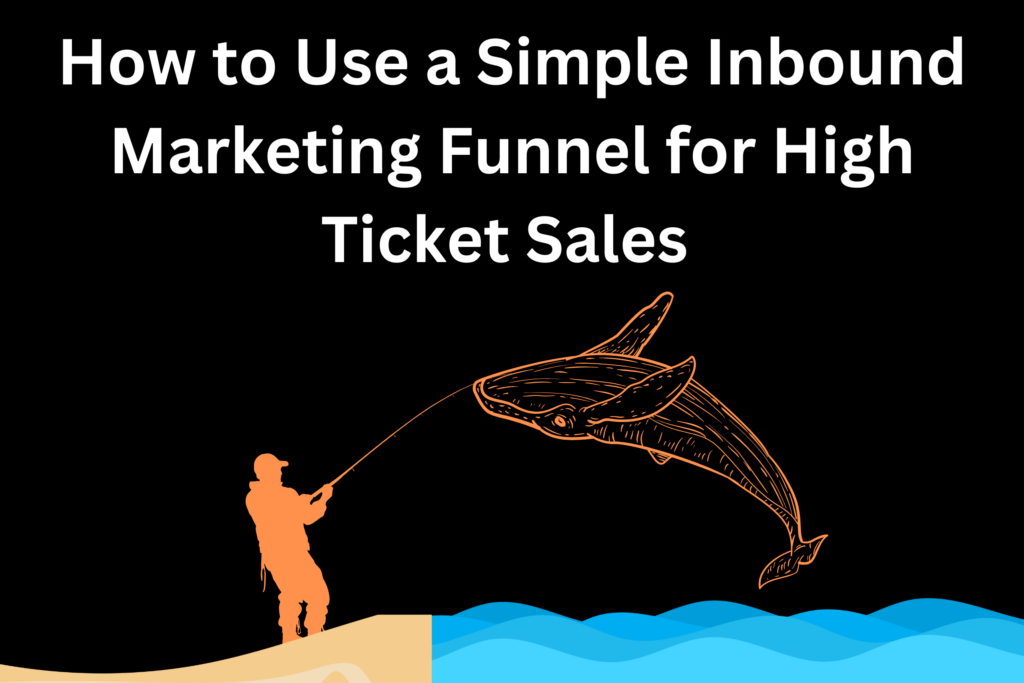How to Use a Simple Inbound Marketing Funnel for High Ticket Sales

By Connor

You were sold on a dream that isn’t true.
The 4-hour workday.
Selling on autopilot.
Infinite leads.
I was sold on the exact same thing. I thought you could just create content and make money. That’s why my first product didn’t make a single sale. Most people don’t even know about it.
Posting content daily.
Spending HOURS engaging.
”Hacking” your way past the algo.
Listening to all the advice about building a brand.
Nothing in your bank account to show for the effort.
Sound familiar?
That’s a more realistic view of the content game. Everyone tells you to give away so much free value your head hurts.
But what do they end up selling?
Personal brand courses about how to build a personal brand. They build this massive audience but have no way to monetize it other than teaching other people how to build a massive audience.
There’s absolutely NOTHING wrong with that model. I want to make that very clear. It does work. Dozens of people are making a great living teaching others how to build a personal brand.
But there’s nothing original about it.
How are you going to compete with somebody like Ben Meer?
The short answer: you’re not.
But the good news is that you don’t have to.
Personal Brand vs. Personal Category
There’s two paths you can take as a creator:
- The personal brand
- The personal category
Both work. But the models are different.
A personal brand is just that: personal. You don’t necessarily sell anything unique. You drive leads from who you are as a person.
That means sharing A LOT about yourself and personal life. You become a persona. An influential figure. A personality.
Then there’s the personal category avenue.
Think of people like Justin Welsh and Codie Sanchez. Their names are synonymous with a certain category.
Justin Welsh = solopreneurship.
Codie Sanchez = boring businesses.
You don’t go to Justin Welsh to get life stories. You go to Justin Welsh to learn about 1-person businesses.
He owns that category.
TONS of people talk about solopreneurship, but nobody owns it like Justin Welsh. You’re not going to him for the personality. You’re going to him for the knowledge.
He has to INTENTIONALLY inject stories into his brand to make it more relatable. But his brand wasn’t built off of personal stories. It was built off of becoming a great solopreneur.
Before he ever sold courses, he thrived as a sales consultant.
He wasn’t making money as a solopreneur by TALKING about solopreneurship. He was making money elsewhere, talked about the lessons he learned, and THEN monetized his solopreneurship content.
Now he sells on autopilot with low ticket and medium ticket offers.
But he didn’t do that right from the start.
Whales and Fish
There are 2 types of followers.
Whales and fish.
Fish are the people who you can sell low-ticket courses to. They’ll engage with your content. They’ll join your newsletter. They’ll buy $27-$297 courses. They may even join a community/cohort.
Whales are different.
You don’t see them showing up in your comments. They’re not reaching out to you for help. They’re not joining your newsletter.
But they’re the people you make life changing money with.
Fish Food
Write content for fish.
Do outbound for whales.
Fish are not a bad thing. At some point, they will make up the majority of your revenue.
That dream you were sold on? It comes from fish.
But it takes a LONG time to build up enough traffic to make a living from your fish.
Let’s look at the math. 3 people at a $2k/mo is $72k/year. Not a bad living at all. To make the same amount of money with a $100 course, you’d have to sell 60/mo. It requires 20 times the amount of people.
Can you drum up that sort of demand with ads?
Absolutely. Russell Brunson made his first million selling relatively cheap courses and building KILLER inbound marketing sales funnels to get people to convert.
But if you’re building your personal brand, my guess is you want to keep things organic.
Side Note: I have NOTHING against ads. If you’re confident you can convert with them, use them. They are ridiculously effective if done well.
And to get those kinds of numbers, you need a ton of traffic. Take a look at this article. These are sites getting hundreds of thousands of page views every month making only a few thousand dollars.
With that much traffic, there are certainly ways they could monetize more effectively to bring their income up, but you get the idea. To earn “passive” income, you need a very engaged audience and a lot of traffic off socials to earn a good living.
The Inbound Funnel
That doesn’t mean you should give up on the idea of selling digital products for a living.
Quite the contrary.
That’s the goal of almost every creator. Build a digital asset once that can sell 24/7, 365. But to do that, you need to start catching fish with an inbound funnel.
Let’s go back to Justin Welsh because he did this so well.
His content was always about the 1-person business model. It helped him grow his social presence. It helped him collect emails. It helped him build a 7-figure asset (his email list).
But do you think he was making tens of thousands of dollars every month from course sales when he had 15,000 followers?
No, he wasn’t.
He had another income source (which we’ll get into in a minute). But just because he wasn’t making a ton of money from his fish doesn’t mean he neglected them. He built with the end in mind: a high leverage, freedom business that you can run with just a few hours per day.
To achieve that, he had to bring fish into his ecosystem.
Social posts for growth.
A daily CTA to get people to his list.
Extremely helpful articles to build trust.
Free lead magnets to get feedback and data.
That is the inbound marketing sales funnel formula.
Bring fish into your ecosystem every day. Nurture them with valuable content. Monetize with low and mid ticket offers.
And that’s exactly what Justin Welsh did. He brought new fish into his ecosystem every single day. And from there, he could nurture them by adding free value and giving them soft-pitches.
Whale Bait
We’ve talked a lot about fish up until this point.
But that’s not where the real money is made. At least at the start.
Justin Welsh began with B2B sales consulting. This is what paid the bills while he was building up a school of fish.
He was a sniper with his outreach. He was very targeted about who he wanted to work with. And did outbound to convert them into clients.
He had 2 offers going simultaneously. 1 for his fish. 1 for his whales.
Solopreneurship. Social media growth. Making money as a creator Those were the offers his audience saw. That’s how he got fish into his ecosystem.
Sales consulting for healthcare startups is the part nobody saw. It’s the DMs. It’s the sales calls. It’s the “unsexy stuff.” THAT’S what built him a business; in other words, his whales.
We just don’t see that part because it’s not flashy.
It’s not the course sales
It’s not the 4-hour workday.
It’s not the romanticized version of entrepreneurship.
But it is reality.
He wouldn’t have made a living just trying to sell courses. He needed to sign clients for $1-$10k while he built up his digital assets.
If you can sign 1-5 clients, you’ve created a full-time income. Then you have the time freedom to focus on building up your fish food so you can sell 24/7, 365 and leverage digital freedom.
How to Catch a Whale
It’s clear that you need high ticket clients.
Anywhere from $1-$10k.
That’s how you make a living as a creator at the start.
But how do you actually do it.
Here’s the playbook:
1. Niche Down
Be the best at SOMETHING.
Sound engineering for technically challenged podcasters.
Time management for healthcare executives.
Cold email for telecom companies.
Marathon training for busy dads.
Cold opens for awkward teens.
You won’t isolate anyone. If you think your niche is too narrow, it’s most definitely too broad.
2. Craft Your Offer
Sell them on the vision.
Sell them on the “new life”
Sell them on the transformation.
List out every step in the journey.
List out 2-4 problems in each step.
List out 1 solution for each problem.
The solutions are the deliverables.
The solutions are objection handlers.
The solutions are HOW you get results.
The offer is where the solutions take them.
3. Strategic Outbound
Write content for fish.
Do outbound for whales.
Conversations = leads
Leads = calls
Calls = sales
Start more conversations. But don’t sell right from the start.
Do some discovery. Build some rapport. Uncover some pain points.
You’re goal is high ticket. Not everyone is a fit. Vet before you sell.
4. Closing Call + Guarantee
Sales is hard.
When you’re first getting started, you don’t need to make it harder on yourself. Follow a template to give you some direction on the call so you always stay in control of the conversation.
Find pain points.
Customize the offer.
Use your solutions as objection handlers.
And then add your guarantee.
A Satisfaction Guarantee is my favorite without social proof. Paired with a best case/worst case close, it’s even better.
Read $100M Offers by Alex Hormozi to learn more about guarantees. There are literally dozens that you can use. Find the one that works best for your offer. And use that one.
5. Time + Volume
This won’t work overnight.
Outbound done right isn’t cold outreach.
It’s about building a relationship over time.
Give it 1-3 months.
You WILL get your fist close.
That’s all I’ve got for you this week.
Have a kickass rest of your day.
